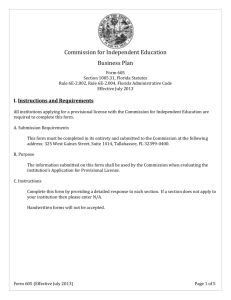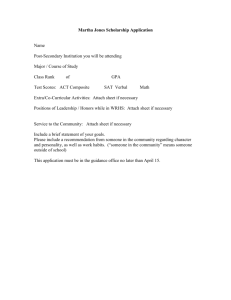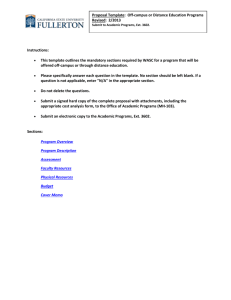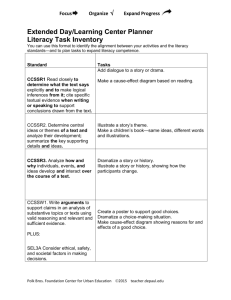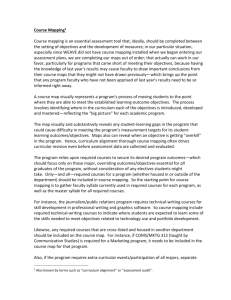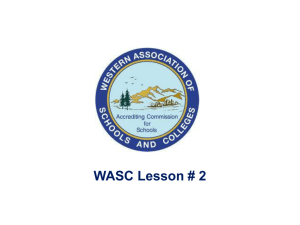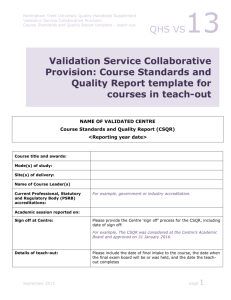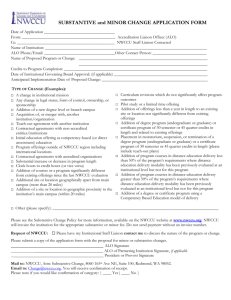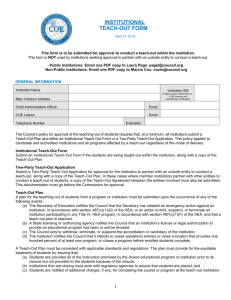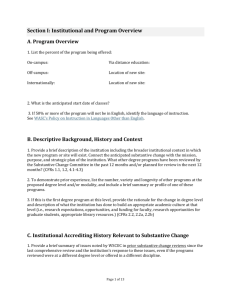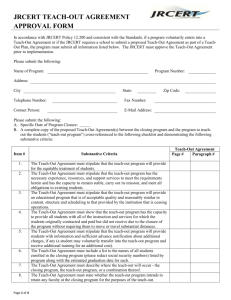UH Manoa Doctoral Distance Program Proposal Template
advertisement
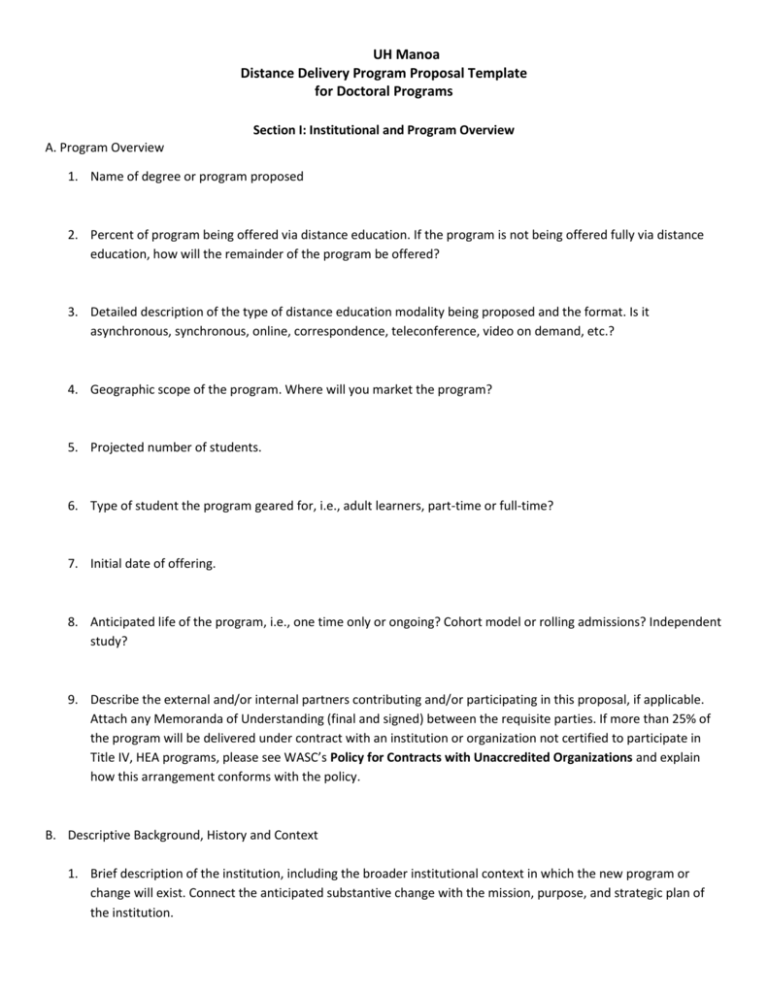
UH Manoa Distance Delivery Program Proposal Template for Doctoral Programs Section I: Institutional and Program Overview A. Program Overview 1. Name of degree or program proposed 2. Percent of program being offered via distance education. If the program is not being offered fully via distance education, how will the remainder of the program be offered? 3. Detailed description of the type of distance education modality being proposed and the format. Is it asynchronous, synchronous, online, correspondence, teleconference, video on demand, etc.? 4. Geographic scope of the program. Where will you market the program? 5. Projected number of students. 6. Type of student the program geared for, i.e., adult learners, part-time or full-time? 7. Initial date of offering. 8. Anticipated life of the program, i.e., one time only or ongoing? Cohort model or rolling admissions? Independent study? 9. Describe the external and/or internal partners contributing and/or participating in this proposal, if applicable. Attach any Memoranda of Understanding (final and signed) between the requisite parties. If more than 25% of the program will be delivered under contract with an institution or organization not certified to participate in Title IV, HEA programs, please see WASC’s Policy for Contracts with Unaccredited Organizations and explain how this arrangement conforms with the policy. B. Descriptive Background, History and Context 1. Brief description of the institution, including the broader institutional context in which the new program or change will exist. Connect the anticipated substantive change with the mission, purpose, and strategic plan of the institution. 2. To address prior experience, list the number, variety and longevity of other similar programs that have been or are being offered via distance education. Include a summary or profile of one of the programs being offered via distance education to demonstrate prior experience. C. Institutional Accrediting History Relevant to Substantive Change 1. Brief response to issues noted in prior substantive change reviews since the institution’s last comprehensive review. 2. Institutional response to issues noted in prior Commission or other Committee action letters or visiting team reports that are relevant to the proposed substantive change. 3. If the proposed program is within a school accredited by a professional accrediting agency, or is related to a program that is accredited by a professional accrediting agency, list the agency, year accredited, and include a copy of the executive summary to the most recent team evaluation report and agency action. Also, indicate whether the specialized agency needs to review and approve the proposed program prior to implementation. Section II: Program Need and Approval A. Program Need 1. Program need/rationale framed by the institution’s mission and strategic goals. 2. Process and results used to establish the need. Please provide a summary of the findings, not the full study. 3. Evidence used to support enrollment projections and to support the conclusion that interest in the program is sufficient to sustain it at expected levels. If the program is planned to be offered for a finite period, provide the enrollment data for the length of the program. If the program is planned to be offered continuously, then provide enrollment projections for the first three years. These enrollment projections should be reflected in the budget. 4. Attach the recruitment and/or marketing plan for the program. Note that all materials regarding this program should clearly state, “Pending WASC approval” prior to Commission ratification. B. Planning/Approval Process 1. Description of the planning and approval process within the institution (and system, if applicable), indicating how the faculty and other groups (administrators, trustees, stakeholders, system office, etc.) were involved in the review and approval of the new site or program. Attach documentation of necessary approvals. Section III: Program Description and Evaluation A. Curriculum 1. Overall description of the program, including the alignment of the program philosophy, curricular design, and pedagogical methods with the target population and degree nomenclature selected. 2. How has the curricular design and pedagogical approach been adapted to the modality of this program? 3. Program learning outcomes that articulate what the student will be able to do after he/she completes the program and are appropriate to the level of the degree. 4. Curricular map articulating the alignment between program learning outcomes and course learning outcomes and demonstrating the progression from introductory to advanced levels. 5. Listing of courses, identifying which are required. 6. Process by which syllabi are reviewed and approved to ensure that 1) course learning outcomes are described and are linked to program learning outcomes; 2) materials are current; 3) pedagogy is appropriate for the modality of the course. 7. Attach three sample syllabi that are representative of the program and attach the capstone/thesis or culminating experience syllabus (if applicable). Syllabi should include specific student learning outcomes for the course, be adapted to the modality of the course, and be appropriate to the level of the degree. Syllabi should also reflect information literacy requirements and use of the library. 8. Internship requirements and monitoring procedures, if an internship is required. 9. Special requirements for graduation, i.e. comprehensive examination service learning, etc. B. Schedule/Format 1. Length of time that the typical student is expected to complete all requirements for the program. 2. Description of the cohort or open registration model being used. Minimum attendance/participation requirements and the provisions made for students to make-up assignments or for students who have to drop out of the cohort for a short period of time. 3. How will the institution ensure that timely and appropriate levels of interactions between students and faculty, and among students are maintained? 4. Please describe how the identity of students participating in the program will be verified. See Best Practice Strategies for Promoting Academic Integrity in Online Education. 5. Timeframe of courses, i.e. accelerated, weekend, traditional, etc. If the course timeframe is abbreviated, an institution must allow adequate time for students to reflect on the material presented in class. Faculty using the accelerated course format should be expected to require pre- and post-course assignments, as appropriate. The Committee will expect course syllabi for accelerated courses to be adjusted accordingly to reflect the pre- and post-course assignments, and the accelerated nature of the curriculum. 6. Sample schedule of courses for a full cycle of the program with faculty assignments, if available. C. Admissions 1. Admissions requirements. 2. Identification of the type of student targeted and qualifications required for the program. 3. Credit policies, including the number of credits that students may transfer in. 4. Process for awarding credit for prior learning (applicable only to undergraduate level). 5. Residency requirements, if applicable. 6. Sample brochure or admissions material. Note that these materials must clearly state “Pending WASC approval” prior to Commission ratification. D. Plan for Evaluating Educational Effectiveness 1. Plan for assessing the program at various stages in the first year, including achievement of student learning outcomes and how findings from the review will be used to improve the program. Attach the assessment plan. 2. Plan for incorporating assessment of this program into the school and/or institution’s existing program review process. 3. Evaluation of the educational effectiveness of distance learning programs (including assessments of student learning outcomes, student retention, and student satisfaction) including appropriate comparisons with campusbased programs. 4. If the program is offered on-campus or in a traditional format, then it would be appropriate to include a summary of a recent program or curricular review to determine of appropriate changes have been made to the proposed program. 5. Description of how the student’s ability to succeed in distance education programs will be addressed and linked to admission and recruiting policies and decisions. 6. Procedures to evaluate teaching effectiveness in the distance education modality. Section IV: Resources A. Faculty 1. Number and type (full-time, part-time, tenured, non-tenured) of faculty allocated to support the program in terms of developing the curriculum, delivering instruction to students, supervising internships and dissertations, and evaluating educational effectiveness. 2. Information about the balance of full- and part-time faculty members involved, and how that balance will ensure quality and consistency in instruction and advising. 3. Analysis of the impact that the proposed program or change will have on faculty workload for all involved in the program, including teaching, research, and scholarship. Who will teach courses no longer being taught by the faculty reassigned to this program? What will be the maximum number of students that each faculty member can advise? 4. Preparedness of the faculty to support the modality of instruction. Are faculty development opportunities available? Include any faculty guidelines for online instruction. 5. Overview of the key credentials and experience of primary faculty responsible for the program. Include abbreviated vitae (3-5 pages) that demonstrate the most current activities in relationship to the program (scholarship, teaching, etc.). B. Student Support Services 1. Assessment of student support needs including, but not limited to: a. Ongoing academic advising and academic support b. Financial aid advising c. Career placement services 2. Availability of support services for students and faculty, including helpdesk hours. C. Information Literacy and Library Resources 1. Description of the information literacy competencies expected of graduates (applicable only at the undergraduate level, CFR 2.2a) and how they will be evaluated. 2. Description of how library resources will be used in the curriculum. 3. Description of what staffing and instructional services have been put in place and what library and informational resources are available to students and faculty, onsite and remotely, in support of this program. Include a description of the library’s information literacy program. 4. If additional information literacy and library resources are deemed necessary, specify what these resources are and detail the institution’s long-term financial commitment to implement this program. 5. Access to library systems (local, national, or global), electronic services, Internet, information utilities, service providers, and document delivery services for both faculty and students. D. Technology 1. Description of the institution’s technological capacity to support teaching and learning in the proposed program. 2. Description of the institution’s provisions for students in the proposed program to gain full access to course materials. 3. Description of the level of technology proficiency expected of students and faculty. 4. Description of how students will receive training on how to utilize program required technology. 5. Description of how the institution will ensure business continuity during system failures (major or minor) or scheduled service interruptions. 6. Descriptions of the provisions available to faculty to ensure that the student is the student completing the coursework. See Best Practice Strategies for Promoting Academic Integrity in Online Education. E. Physical Resources 1. Description of the physical resources provided to support the proposed program(s) and the impact of the proposed change on the physical resource capacity of the institution. This includes, but is not limited to, the physical learning environment—classrooms, study spaces, student support areas. F. Financial Resources 1. Assessment of the financial viability and sustainability of the program including: a. Narrative describing all start-up costs for the institution and how the costs will be covered (including direct program cost and institutional indirect cost). Cost for licensing, hardware, software, technical support, training for faculty and students, and instructional design should be included. b. Total cost of the program to students, including tuition and any special fees. c. Financial impact of the change on the institution including evidence that the institution has the capacity to absorb start-up costs. If the institution has incurred a deficit in the past three years, supplemental information describing the financial capacity of the institution to start and sustain the new program(s) is required. d. Statement of the minimum number of students per year necessary to make the program financially viable. The budget should reflect anticipated attrition and should include plans to respond to low enrollment. e. Budget projection, for at least the first three years of the proposed program, based on the enrollment data in the market analysis and including projected revenues and costs. The budget should include all budgetary assumptions. (The attached budget template is provided as a model of the level of detail the Committee expects, but is not required. The template may be modified as appropriate.) Section V: Teach-out A. Teach-out 1. Teach-out plan detailing how students who begin this program will be able to finish if the institution determines that the program is to be closed. Please see WASC’s Policy on Teach-Out Plans and Teach-Out Agreements.
